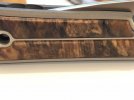- Joined
- Jan 8, 2018
- Messages
- 130
it just dawned on me that the spalted beech inlays have a grain pattern that runs perpendicular to the length of the inlay... This would make it prone to breaking. I would assume that this is an exception to most of the CRK inlays.

